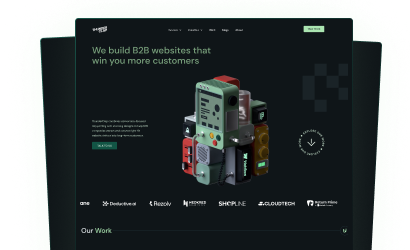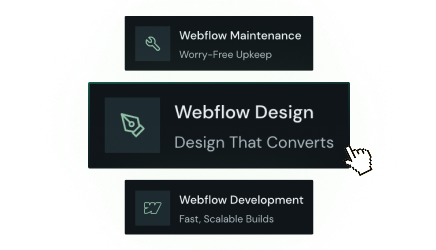3 guesses about you, just based on the fact that you landed on this blog:
1. You finally busted the myth that WebFlow websites don't need maintenance.
2. You're on the fence about whether to outsource WebFlow maintenance or manage it in-house.
3. You're looking for a no-BS guide that helps you choose the right model.
If that sounds like you, this blog is for you. Here we discuss whether outsourcing WebFlow maintenance is better than in-house management based on 6 parameters: cost, expertise, scalability, availability, risk monitoring, and time to market.
But first, let's cover the basics:
What is WebFlow maintenance?
WebFlow maintenance is the process of keeping your WebFlow websites updated, secure and primed for peak performance and conversions. During WebFlow website maintenance checks, you run:
- Security Checks: To scan for potential threats and ensure that in-built security features, such as two-factor authentication, SSL encryption, and DDoS protection, are functioning properly.
- Content Audits: To ensure that both static pages (such as About and Pricing) and dynamic ones (like Blogs and Case Studies) always showcase the latest and most relevant content.
- SEO Audits: To catch broken links, missing ALT texts, meta tags, and avoid domain expiry.
- Accessibility Checks: To ensure you comply with the web accessibility guidelines and provide a seamless user experience.
- Backup and Recovery Audits: To confirm WebFlow's built-in backup is reliable and ensures quick recovery after errors or cyber threats.
Does WebFlow even require maintenance?
Contrary to some popular Reddit Threads, WebFlow websites do require maintenance. However, the effort and time one should invest in WebFlow maintenance is minimal compared to other website builders like WordPress.
Qamar Aziz, ThunderClap's Webflow Lead & GSAP Developer, has to say about the need for WebFlow website maintenance:
"A Webflow website is like a living system, without regular maintenance, even the most beautifully designed site can suffer from broken links, outdated content, performance issues, or missed growth opportunities. Ongoing maintenance ensures your website stays fast, secure, and aligned with your business goals."
Outsourcing Webflow Maintenance vs. In-House Management: A Comparison
Now that we've pushed the question of whether you need Webflow maintenance out of the way, let's zero in on how outsourcing stacks up against in-house management across cost, expertise, scalability, availability, speed, and risk monitoring.
1. In-House Vs. Outsourcing WebFlow Maintenance: Which Costs More?
Outsourcing is a cost-effective option compared to in-house WebFlow maintenance. Here's why:
- No additional costs, pay only for the service: When you outsource WebFlow maintenance, you only pay for the service. On the other hand, hiring in-house WebFlow specialists requires you to cover their onboarding and training in addition to their salaries.
- No need to invest in a maintenance tech stack: WebFlow maintenance agencies come with an advanced set of tools to ensure your website is optimized for performance, user experience and conversions.
- Maintenance never becomes a second priority: Outsourcing WebFlow maintenance gives in-house teams the liberty to focus on core priorities without feeling guilty about sidetracking website maintenance.
2. In-house vs. Agency: Who's More Skilled at Managing Webflow Websites?
Short answer, WebFlow agencies. Here are some factors that make them more competent at managing WebFlow websites than your in-house team:
- Proven expertise in your industry: WebFlow maintenance agencies like ThunderClap have proven experience in select fields like SaaS, venture capitalists, e-commerce, etc. This means they are well-versed in the industry's trends and best practices, and can replicate similar results for you in no time.
- Experience handling WebFlow websites: WebFlow partner agencies are vetted by WebFlow and trained to stay on top of new WebFlow features and updates. This means issues your in-house team might take weeks to fix are usually handled by agencies in hours with their battle-tested workflows.
- Access to a panel of specialists: In-house website maintenance is usually performed by one or two generalists who manage 5 other tasks between this. On the other hand, agencies come with a dedicated panel of specialists, including designers, strategists, developers and SEO and CRO experts, ready to take action on demand.
{{specficBlog}}
3. In-House vs.Outsourcing: Who Handles Webflow Scaling Better?
WebFlow websites are built for scalability. But knowing how to use features like Components, Global Styles and Symbols strategically to build scalable websites is a skill not many possess. And that's where WebFlow maintenance agencies outshine in-house maintenance teams, making them a better alternative:
- Implements a strategic design system: WebFlow agencies are trained to think long-term from the very beginning. They focus more on building a website architecture that can seamlessly accommodate new pages and products. Your in-house team often lacks this strategic design thinking unless they are certified WebFlow experts and may end up building siloed one-off pages.
- Handles maintenance for multiple websites: Handling maintenance for multiple websites is not a big deal for agencies as they have predefined workflows, playbooks and a dedicated team in place. However, your in-house team may find it difficult, especially if they are juggling multiple tasks at once.
- Proper documentation and better handoffs: Agencies equip you with component libraries, workflows, and design systems to make future scaling easier (with or without their support). You won't always get this level of clarity with your in-house team, especially when there's no defined process or need for handoffs.
4. In-House vs. Outsourcing Webflow Maintenance: Which Team Is More Available?
While in-house teams may seem more available from the outside, this isn't usually the case. Here are the reasons why agencies are more reliable:
- Functions as per service-level agreements: Maintenance is not an afterthought for agencies, as they are often bound by service-level agreements with specified scopes and timelines. This means they prioritize your maintenance requests, unlike in-house teams, where such tasks may be sidelined due to multiple responsibilities.
- Dedicated team to perform maintenance: Outsourcing Webflow maintenance gives you access to a panel of experts who can handle everything from recurring tasks like performance testing to advanced requests like third-party integrations. In contrast, in-house maintenance is often handled by generalists or delayed until the right experts have bandwidth.
- Website performance is their KPI: When you hire a WebFlow agency for maintenance, ensuring your website is well-maintained and high-performing becomes their key priority. Their reputation is tied to it, so they never slack off on it. This level of holistic maintenance is rare in in-house management, as it's usually handled alongside a million other tasks.
5. In-house vs. Agency: Who's Better at Risk Monitoring?
Unless your in-house team includes WebFlow experts and a predefined risk monitoring process, it is better to outsource it to an agency. Here's why:
- Structured risk monitoring: Agencies have structured processes for risk monitoring, including playbooks, security and recovery audits, QA checklists, backup testing, and rollback plans. This helps minimize issues and reduce your website's downtime if things go south.
Managing Webflow maintenance in-house without clear processes makes your website more vulnerable to risks and can take longer to recover.
- Access to advanced risk monitoring tools: Mean Time to Detect (MTTD) and Mean Time to Resolve (MTTR) are key KPIs agencies track during risk monitoring. That's why they invest in advanced monitoring tools that flag issues before they snowball into something bigger. Most in-house teams lack this setup, reducing the chances of early detection and timely resolution.
- Proactive risk mitigation: With experience managing dozens of Webflow sites, agencies know exactly how to fix issues before they escalate. Instead of trial and error, they go straight to the root cause, guided by structured workflows and supported by advanced tools.
In-house teams often lack that depth of experience, spending hours manually digging through settings just to understand what went wrong.
6. In-House vs. Outsourcing Webflow Maintenance: Who Gets You to Market Faster?
Time-to-market is one of the strongest factors that puts outsourcing ahead of in-house WebFlow maintenance. Here's why:
- Designed for high-growth teams: Agencies are purpose-built for high-growth brands with a 'get things done' attitude. With predefined workflows, advanced tools, and a team of experts, they never stall, they ship fast. In contrast, in-house teams often delay maintenance due to internal priorities, approval bottlenecks, and bandwidth issues.
- Competitive timelines: Agencies are accountable to deadlines and always find the fastest route from concept to launch. Maintenance requests don't receive the same urgency in-house and are often pushed to the back burner unless a security threat or downtime is involved.
- Works on multiple requests in parallel: Agencies have the bandwidth to take on multiple requests at once. They can scale their team up or down based on your needs. This isn't possible when managing maintenance in-house, as you often have a fixed team with fixed bandwidth.
Outsourcing WebFlow Maintenance Vs. Inhouse Management: TL;DR Version
Final Verdict
After comparing in-house management with outsourcing, only one question remains: 'Which model fits your team best?'. And here's how you decide:
1. In-house management works best when:
- You have a team of trained WebFlow specialists with available bandwidth.
- Your maintenance requests are minimal and not bound by tighter deadlines.
- When you have enough funds to invest in hiring, training and tool subscriptions.
2. Outsourcing it to an agency works best when:
- You want Webflow maintenance to run on autopilot with minimal supervision.
- You need a proactive risk mitigation system to ensure both security and performance.
- Multiple requests need to be handled simultaneously without compromising deadlines.
3. A hybrid approach is the one for you if:
- You are planning to scale your website’s content, structure and functionalities and want to reduce the time to market.
- You have fluctuating demands and want agency support only during periods of high demand.
- Experimentation is your priority, and you'd rather ride on an agency's expertise than build from scratch.
Looking for a WebFlow maintenance partner? ThunderClap might be your answer.
ThunderClap is a WebFlow development agency that offers maintenance plans for B2B brands of all sizes, from startups and mid-level brands to enterprise ones. Here are the reasons why ThunderClap might be a good WebFlow agency to outsource your WebFlow website maintenance to:
- Proven B2B experience: We've experience working for notable B2B brands like Storylane, Z47, Amazon, Razorpay, Skyroot and Shopline. This means we are always on top of updates, trends, and best practices concerning major B2B industries, such as SaaS, Space Tech, VCs, and Fintech.
- Offers comprehensive website maintenance: Our website maintenance plans include unlimited content updates, bug fixes, CMS management, performance engagements, security updates, third-party integrations and backups.
- Competitive timelines: We complete small requests within 24-48 hours, while larger projects, such as design requests, are completed within 2-4 weeks.
{{specficService}}
FAQs
1. Do WebFlow websites require maintenance?
Yes, WebFlow websites require maintenance to ensure your website is optimized for performance, user experience and conversions. While WebFlow handles certain maintenance tasks like security updates and backups on autopilot, you still need to manage content updates, SEO updates, risk monitoring and resolution, page additions or feature updates on your own.
2. Should I outsource WebFlow maintenance or manage it in-house?
- In-house management is best if you have WebFlow specialists on board with available bandwidth or if your maintenance requests are smaller and less time-consuming.
- Outsourcing is a better option if you want maintenance to be on autopilot with minimal team involvement.
- A hybrid approach, where you combine the best of both worlds, suits you if you want to test out new ideas fast without trial and error.
3. Can a WebFlow maintenance agency handle WebFlow maintenance for multiple websites?
Yes, agencies like ThunderClap have the capacity, tech stack and workflows to handle maintenance for multiple websites at once, built from their experience managing 129+ websites.
4. How to ensure my WebFlow websites stay secure during maintenance?
Talk with your agency to know more about the security measures they take during maintenance. For instance, ThunderClap's team constantly monitors for vulnerabilities, conducts regular security audits, applies the latest WebFlow patches, and ensures SSL certificates are up to date.





.png)



Interested in seeing what we can do for your website?


















